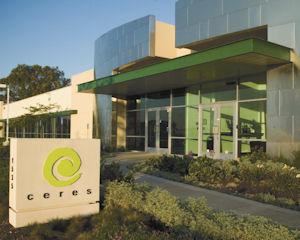Seed maker Ceres Inc. recently filed plans to go public in an initial public offering of up to $100 million. The Thousand Oaks-based company filed its application with the U.S. Securities and Exchange Commission late last month. It didn’t disclose when it plans to start trading its shares or at what price it hopes to sell its stock. The move may signal growth for the company, which employs about 85 at its local headquarters. Ceres said it plans to use the net proceeds from the initial public offering for seed production, product launches, research and development, capital expenditures, and other purposes. The company also said it also may use a portion of the net proceeds to expand its business through acquisitions of other companies, assets or technologies. Ceres uses advanced plant breeding and biotechnology to develop energy crops as raw materials for renewable transportation fuels, electricity and bio-based products. Analysts say going public may help Ceres to raise its profile in the global biofuels market, become profitable and grow operations. “This will certainly take the company from pre-revenue to being a truly viable company in terms of generating revenues for profit,” said Jim Lane, editor and publisher of BioFuels Digest. Ceres has posted net losses almost every year since it was founded in 1996, and company officials have projected those losses will continue as it increases spending on research and developing new products. In the six months ended in February 2011, Ceres posted a net loss of $11.3 million. Revenue for the period was $3.3 million. The vast majority of the company’s revenue comes from government grants and collaboration agreements. Product sales were just $9,000. Company officials declined to comment on the announcement, citing the quiet period following the filing of its registration statement, said company spokesman Gary Koppenjan. The company’s plan to go public comes at a good time, Lane said. Ceres is looking to expand its business, particularly in Brazil, and this will increase its visibility and raise interest among potential investors, he said. Expanding in Brazil is a strategic move. One of the company’s main crops is sweet sorghum, which produces ethanol and complements sugarcane production. Brazil is the world’s second largest producer of ethanol. By growing its crops in places like Brazil, Ceres can extend the production season by 60 days or more, Lane said. And as the Brazilian economy grows, the need for more fuel will increase, he said. “This is a big market for Ceres,” said Lane. Before Ceres can sell the crop, the Brazilian government first must approve it for sale. Ceres is more than halfway through the country’s approval process, according to the public filing. The company said it expects to complete the application process later this year. The future Going forward, the company still faces many challenges – both from a product standpoint as well as a financial one, analysts say. The variations of Ceres’s crops are still fairly new and their advantages remain to be seen, said Steve Shaffer, an independent environmental consultant for agriculture and former director of the Agriculture and Environmental Stewardship with the California Department of Food and Agriculture. “Some versions have been around for 20 years, and now Ceres is taking that to a new step,” he said. Ceres also could face difficulty attracting venture capital investors with deep pockets to fund its research and development efforts, said Heather Youngs, analyst at the Energy Biosciences Institute, UC Berkeley. Another roadblock could be getting farmers to plant new crops, she said. “Ceres is investing a lot of money in a new market and making new feedstocks with hopes that farmers and biofuel producers will want it,” she said. Finding financing for large-scale biofuel projects is a challenge because investors don’t like to take risks on new technology, Lane said. “You have to get commercial scale projects completed through non-traditional finance,” channels, he said. Another hurdle for Ceres could be strict federal and state regulations regarding renewable fuel energy, said Dan Sperling, professor of transportation engineering and environmental policy at the University of California, Davis. The federal Renewable Fuel Standard, under the Energy Independence and Security Act of 2007, increased the amount of renewable fuel that’s required to be blended into transportation fuel from 9 billion gallons in 2008 to 36 billion gallons by 2022. California’s Low Carbon Fuel Standard calls for a 10 percent reduction of greenhouse gas emissions from the state’s transportation fuels by 2020. Both standards create a huge demand for advanced biofuels, Sperling said. However, the U.S. Environmental Protection Agency has been weak in enforcing regulations, in turn, causing venture capital investors like the oil industry to hold off on funding, he said. “If the oil industry believes the EPA will have a spine and enforce the rules, and that California will be firm in following through on the low carbon fuel standards, then I think the financial flood gates will open up pretty soon,” Sperling said. The policies in place for renewable energy consumption could either create a challenge or a great opportunity for companies like Ceres, Lane said. But so far Ceres is on the right track, he said. “A lot of nice things are coming in the future for the biofuel industry,” Lane said. If Ceres can avoid some of the potential pitfalls, its long term future is promising, Sperling said. “This is exactly the type of energy that is needed,” he said. “People agree that it is tremendously important for the future of the country and for the world.”
